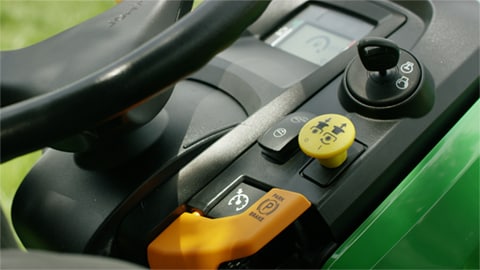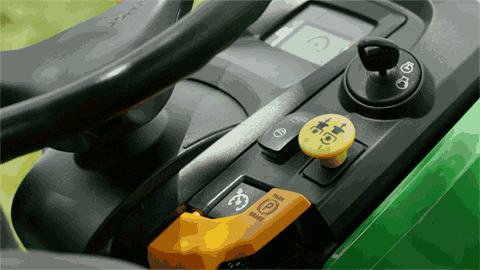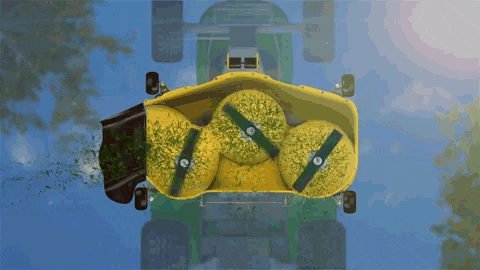
What is mulching? Why should I consider doing it? How will it make my lawn look better? Learn all about mulching now.

What is mulching? Why should I consider doing it? How will it make my lawn look better? Learn all about mulching now.
Grass mulch can help keep your lawn healthy and looking its best. It’s easy to do with our many lawn mower and mower deck offerings.
Check out the tractor mower compatibility.


The easy way to feed your lawn. To make grass mulch, grass is cut into easily absorbed grass clippings to help keep your lawn healthy and lush.


The John Deere MulchControl™ Kit with One-Touch Technology is the easy way to mulch. With the push of a button you can mulch when you want to.


Push the button and mulch. The chute closes and you have a dedicated mulching system. Perfect for regular, weekly, or bi-weekly mowing.


Push the button again, or pull the lever, with your MulchControl™ System, the chute opens and you can side-discharge mow or bag. The choice is yours.
Fertilizing your lawn just got easier. Just let your grass clippings do the job for you. Grass clipping mulch is the natural way to feed your lawn essential nutrients. Here are eight things you need to know:
1. Mulch mowing allows clippings to be cut finely enough so that they can’t be seen when redistributed into the lawn.
2. Make sure your blades are sharp. Sharp blades help ensure a precise, quality cut.
3. Mulching returns nitrogen-rich nutrients to your lawn. This feeds your lawn and can reduce the amount of fertilizer you need.
4. Follow the “one-third” rule when mulch mowing, taking no more off than the top third of the grass blade. Fast-growing conditions will warrant more frequent mowing.
5. Mulching works better when the grass is dry.
6. The MulchControl™ System from John Deere is the easy way to mulch while you mow.
7. If tall or wet grass conditions result in unsightly clumps, your MulchControl™ System should be used in side-discharge mode.
8. If conditions warrant using your MulchControl™ System in side-discharge mode, clippings are likely to be visible for a few days as they decay.
This exclusive technology is available with One-Touch Technology on the John Deere X350 Select Series Riding Lawn Tractor with a 42-in or 48-in Accel Deep™ Mower Deck and other Select Series mowers.
MulchControl™ Kits, with the pull-of-a-lever technology, are available on S240 Riding Mowers with Accel Deep™ Mower Decks, Select Series Mowers, Signature Series Mowers, and all Residential ZTrak™ Mowers.
All MulchControl™ Kits from John Deere include mulching blades for best grass mulching results.
Who loves lugging a heavy bag of lawn clippings to the compost pile or yard waste bin, or endlessly raking leaves in the fall? Pretty much nobody, that’s who. Fortunately, for the sake of aching backs and nutrient-hungry lawns, it’s best to forgo the bag and opt to mulch lawn clippings and leaves instead.
Each little bit of plant material is full of nutrients, and being organic matter, when left in place, can improve the overall health of the soil which in turn, better supports the turf and potentially decreases inputs.
“In the lawncare industry, we’re realizing that rather than feed the lawn synthetically with fertilizers, we can choose to do it more organically by mulching grass clippings and leaving them on the lawn to sift in,” says Richard Hentschel, University of Illinois horticultural extension educator. “Leaving clippings on the lawn provides the equivalent of 1 pound of nitrogen per 1,000 square feet of lawn. That’s nitrogen you didn’t have to buy and apply.” Removing the clippings means also removing those nutrients from the system.
Besides nutrients, clippings return carbon to the soil, which helps build soil organic matter by feeding the microflora that decomposes that organic matter. Soil organic matter (SOM) is measured as a percentage of organic matter in the soil and is the primary indicator of soil health, and therefore the health of the lawn growing in the soil. The higher the percentage of SOM, the more nutrients and water the soil can retain.
“Every 1 percent of SOM holds 1/3 gallon of water per cubic foot of soil,” Hentschel explains. “So, a soil with a fairly good measurement of 3 percent SOM can hold as much as 1 gallon of water per cubic foot.” The ability to hold more water means more of the water applied to the soil through irrigation or falling on the lawn as rain will stay put and turf will be more resistant to swings in temperature and drought conditions.
“SOM also is Mother Nature’s slow release fertilizer. It’s not just the usual nitrogen, phosphorus, and potassium either, it’s all 16 of the nutrients essential for plant growth,” Hentschel says. Constantly removing lawn clippings and other organic matter results in decreasing levels of SOM, and lawns will become increasingly dependent on the application of synthetic fertilizers.
Plan AheadWhile lawns benefit from clippings, they don’t want to be smothered by them. Using best mowing practices can leave grass room to breathe and looking as clean as it would with bagging. The key is to mow with sharp blades and frequently enough that no more than 1/3 of the plant tissue is removed per cutting. This will result in less plant material for the lawn to reincorporate per pass.
“If you mow often with a sharp mower blade, even a conventional mower — as opposed to a mower designed specifically for mulching — will cut the grass up fine enough for it to sift back into the standing grass and break up quickly releasing nutrients to the soil and growing grass as it decomposes,” Hentschel says.
It may be a relatively simple task to stay ahead of grass to get a nice fine mulch that disappears quickly into the lawn, but what about leaves in the fall? Hentschel says to go ahead and mulch them, too. Leaves should be mowed frequently as they fall. To ensure finely parsed leaves that will move into the thatch layer more quickly, it may be necessary to make two or more passes with the lawnmower per mowing. When more leaves fall, simply keep making passes to chop up the material and help speed the composting process.
Hentschel says the leaf residue will work its way into the soil taking valuable nutrients with them and creating a barrier that can help control weeds. With multiple years of mulching leaves, which returns more nutrients to the soil through the extra organic matter, lawns may not need as much fertilizer in the spring. And because the leaf residue covers up bare spots where weeds can gain a foothold, it’s possible over time to see fewer dandelions and crabgrass issues after multiple years of mulching.
No raking, no lugging, less fertilizer, more efficient water use, and fewer weeds—for once, the easy choice is also the best choice. Go ahead and leave the mower bag in the shed if you’re so inclined, and leave the organic matter right where it belongs, on the lawn.
MulchControl™ System Compatibility
11:57:37
| 42-in Accel Deep™ Mower Deck | 48-in Accel Deep™ Mower Deck | 54-in Accel Deep™ Mower Deck | 54-in High-Capacity Deck | 60-in High-Capacity Deck |
|---|---|---|---|---|
| 42-in Accel Deep™ Mower Deck | 48-in Accel Deep™ Mower Deck | 54-in Accel Deep™ Mower Deck |
|---|---|---|
3 Mower Decks Designed to Bring You Great Looking Lawns
Wider and higher discharge opening provides even clipping dispersal for an excellent finished appearance in all conditions.
The deeper draw and flat-top design create a better quality of cut at faster ground speeds.
Tested and proven. Smooth underside prevents grass buildup and clumping.

Deck Spotlight: Accel Deep™ Mower Deck
Flat-top design enables clean flow of material throughout the deck and out of the discharge area. This prevents cut material from interfering with the cutting of incoming grass, allowing the blades to cut the material cleanly.
Deep, flat-top deck with a large discharge opening allows cut clippings to exit the mower deck with limited re-cutting, so more power is available for cutting and processing incoming grass.
Minimal recutting improves the mower's capacity to maintain excellent mowing performance in difficult conditions and at higher speeds.
Smooth, flat-top deck stamping has few places for material to catch and collect on top of or underneath the deck, so the mower deck stays cleaner and is easier to clean when serviced.
Limited amount of recutting means less small pieces of grass clippings collect on the mower deck or the operator.
Designed-in strength and durability features ensure many hours of trouble-free operation.
With the optional MulchControl™ kit installed (along with the special mulching blades that are included), changing from side-discharge to mulching or vice versa is done with the simple flip of a lever or touch of a button.